Karlovy Vary is magical. I was there in 1999 while I was studying abroad in Prague. Clear water below foot bridges, buildings and castles that I wanted to eat because they were so pretty, a winding hill, healing hot springs, quiet. It felt like a dazzling secret, tucked away in a part of the world that few had seen.
When the 2006 movie The Last Holiday came out, set mostly in Karlovy Vary, I was also charmed. In the movie, Queen Latifah’s character lives in a small town and works as a salesperson at a department store when she learns that she has a terminal illness. Tired and fed up with her so-so life, she opens her Book of Possibilities and starts living it.
Yes, Queen.
As a coach, I witness moments when a person is finally willing to live in their Book of Possibilities. This might start with a deep exploration of understanding what you want. It might be a call to live with more purpose and lead with your values. It might mean a career change, starting an initiative that deeply matters to you, standing up for something you care about, leading a team to do something unique, or living free of self-sacrifice.
It is possible.
Seeing new possibilities often happens from moments of challenge, and the desire to reflect, assess, investigate, and reimagine.
When you stop seeing the status quo as the obvious choice, you start to make more conscious choices, and this can be counter-culture. You will inevitably face resistance – both internally and externally.
Oscar Wilde said,
“Yes: I am a dreamer. For a dreamer is one who can only find his way by moonlight, and his punishment is that he sees the dawn before the rest of the world.”
There’s a magical element to seeing what others cannot see, and breaking through your own thinking to imagine something new, different, and invigorating. And you might be the first to see it.
So, how do you take on a possibility mindset?
Possibility.
Noun. a thing that may happen or be the case.
Possibility starts within.
Self-Awareness
Our inner world is created by our unique life experiences, our unique constellation of feelings, our unique survival traits, our unique relationship to ourselves and others. Culture, identity, and social norms also shape the prism through which we view the world. Our inner world reinforces what it knows by inviting or barring certain kinds of thinking or experiences into our lives. We can get into the loop of static thinking.
Imagining new possibilities means that we consciously and willingly need to invite new perspective into our lives and work so we can expand.
And it’s hard to expand.
I heard this story from psychologist and meditation teacher, Tara Brach.
Mohini was a tiger who lived most of her life in a lion house, a 12x12 cage with iron bars and a cement floor. She spent her days pacing her cage, most likely feeling bound and stuck. When she was moved to the Washington DC National Zoo, she moved into a replica of a natural habitat - acres of grassy hills, trees to climb and scratch, a pond, and diverse vegetation. But Mohini spent the remainder of her life in a corner of that habitat, wearing down a 12x12 patch of grass.
At times, we are Mohini. We are majestic and strong humans with amazing stories of love, triumph, genius, transformation, and beauty. We’ve been in restrictive environments, relationships, and situations that makes us long for freedom, expression, bigger ideas, bigger lives, more meaning, more understanding, more love, innovative and impactful change – and yet we can be bound and stuck.
When you consider possibilities for transformation, how much or little do you relate to Mohini’s experience of staying bound in a boundless place?
To unlearn the cage, we first need to see that we’re in it.
Self-awareness gives you a ground to stand on, and gives you power to make choices in how you want to be in the future.
Possibility mindset is about stepping into “I don’t know space”, to imagine something beyond what we know today, beyond what we see today, beyond what we feel today.
How can you hold a vision of peace for the world when you see strife? How can you think bigger about your business when you feel scared you won’t meet financial goals? How can you create more ease in your life when you feel overwhelmed? How can you lead a cross-functional team to bring a product to market when the team is in conflict?
Often, our go-to thought is – it’s not possible. I’m asking too much of myself. You’re asking too much of me. I’m asking too much of you.
This is the rub. Wanting transformation means doing things that our old ways of thinking can often keep us from doing.
We can’t get there with the tools we have here. If we are to expand, create, innovate, then part of us needs to die.
Compassion
Years ago, I dated someone who told me about all the boxes she puts around herself, and her boxes had boxes around them, and then she puts boxes around other people. Oh boy. I was listening to her share this on a work trip in Miami, looking out on the ocean, feeling the sun on my skin, and feeling wrecked that another beautiful person couldn’t take the sunshine.
Usually, self-imposed constriction is a move to feel more emotionally safe.
That safety might be protection from others, or from unhelpful thinking we’ve internalized.
Often, dreaming is followed by fear. We start yearning and dreaming, and we shut it down immediately because we’re afraid we’ll fail, afraid we’ll waste our time, afraid of taking a risk, afraid of making an effort.
To expand feels unsafe. So, let’s offer ourselves and each other compassion. Offer gratitude to that old self. Give yourself permission to let a part of you or your beliefs die. Allow a new version unsteady version of you to emerge.
A chick born from his or her little egg has got to feel scared out of his or her tiny little mind. Their cozy small world is cracking open, light is coming in, and it’s scary.
So little chicks, be easy on yourself as you expand, and know that you are a little chick among other little chicks. These little chicks are your managers. These little chicks are your CEOs. These little chicks are on your team. These little chicks are people you are in conflict with. These little chicks are people who you love. They want to feel safe. They need resources.
Compassion the hell out of yourself and each other.
In Atlas of the Heart, Brené Brown defines compassion as “the daily practice of recognizing and accepting our shared humanity so that we treat ourselves and each other with loving-kindness, and we take action in the face of suffering.”
Humanity feels longing and pain; happiness and darkness; love and fear. To move through the shadow thinking and negative self-talk that comes up when we start to think in possibilities, offer yourself love and take action.
Easy does it, but do it.
And please, don’t do it alone. We have shared humanity, and humans are wired to connect. Allow yourself to be witnessed by friends, family, a therapist, a coach, a community.
Perspective Shifting
As you practice compassion, allow your mind to expand to possibility with some perspective shifting activities.
Perspective shifting starts with asking yourself,
“How do I know what I know?”
What life experiences, systems that you live within, cultural influences, identify factors, and beyond shape how you think? From there, we can play around with our frames to open up blind spots and see from new angles. We shake up our automatic thinking, and open to new possibilities. This can also help us shift others’ perspectives, open minds, and make change.
I’ll share some perspective shifting exercises that you can adapt and scale for yourself, your team, and for bigger systems – all for the purpose of shifting to possibility thinking.
· Daydream
· Retreat
· Inspiration
· Cross-Pollination
· Rebel
· Support
Daydream
A dear friend lovingly suggested that I daydream about a thing I was grappling with.
How would I love for it to go?
I felt my shoulders sink. I felt my body settle. I saw and felt possibility.
Allow yourself to daydream. Visualize the possibility as an everyday practice.
Set aside time for your mind to wander every day. You can start with 5 minutes while you drink coffee or take out the trash.
Grow that to 30 minutes once a week. For a longer session, you might daydream while looking out a window, showering, walking, chopping vegetables, driving, or staring at a wall.
Daydream with all of your senses. What music, scent, tactile sensation, tastes, mood, location, feelings, and other elements of the environment conjure the possibility that you wish to explore?
Create a new world with your senses as you daydream.
Retreat
Expand the 30 minute daydream to a full on retreat. This could be an afternoon, a long weekend, or a sabbatical. Go to a new environment. Do something new. Learn something. Allow your mind to unfocus. Mull things over. Give yourself thinking time. Our culture is often focused on doing, achieving, checking off the boxes. Retreat is an oasis for being and thinking. It’s a supportive environment for reimagining.
Ideas for a new business might emerge. Ideas for a new career might emerge. A sense of openness and excitement for a change might come to be. A decision might become clear. Retreats support us to know what we want.
Retreats also work for teams.
Who are you?
What matters to you now?
What are your challenges?
How will you work together to face the challenges?
How do you want to develop?
How do you want to be together?
What values matter most to you?
What future do you see for your team and your company?
Giving your team space to share and grapple with time to snorkel or sit by a fire opens up possibilities.
Inspiration
What person, work of art, place, concept, social movement, and beyond move you, make you feel alive, fill your soul? Think about this deeply. Allow yourself time to explore this.
Think of 6-8 sources of inspiration – your muses - and write them down.
What characteristics does each have? Write that down.
What qualities do you aspire to in your muses, and what qualities do you already have?
When you notice who or what inspires you, go back to them for inspiration. Have a possibility that you’re considering? Apply one or more of these muses to this possibility. It’s a WWJD moment, but you choose who Jesus is.
You can do this with your team, too!
I love facilitating these conversations – it gets fascinating, deep, connected, and invigorating. When you know who or what inspires and enlivens your team members, you will have a more inspiring, enlivening, engaged team open to creating possibilities together.
Cross-Pollination
We often see from our perspective only. We come from a certain discipline. We are marketers. Product people. Engineers. People people. Strategy people. Experts in a financial sector.
Bring different disciplines, perspectives, and worldviews into your thinking, and see your possibility from different angles. Allow cross-pollination to create new possibility.
You might seek out different perspectives about an idea you are pursuing. Set up calls with 5-6 people who are different from you, and have conversations.
You can cull the perspectives of people on your team. This can be as simple as asking people on your team,
How do you see this?
Other perspectives?
Asking “other perspectives?” is one of the simplest and most powerful questions you can ask to open dialogue. You will see from new angles, understand an idea more richly, and expand how you can solve a problem.
Rebel
People resist change, including ourselves.
Sometimes it’s an internal thing, and sometimes it’s because we or others are thinking provincially, when you want to think galactically.
When and if you get resistance, doubt, or pushback…
Rebel.
In 1962, after an audition with an exec at Decca Records, the exec told the Beatle’s manager that they didn’t have a future in show business.
Rebel.
Keep going until you fully explore the possibility. Use controversy, conflict, or friction in a healthy way to generate something better than the status quo.
Find others’ who will support your vision.
Fuck the data.
Listen to Bozima St. John, Chief Marketing Officer at Netflix. Her Ted Talk explores intuition.
This takes us out of the realm of probability, and into the realm of possibility. The statistics might not be in favor for a person who grew up poor to become financially free, a formerly incarcerated person to become a tech exec, or a serially monogamous person to find a lasting love later in life.
But belief isn’t about how likely something is. It’s about knowing that it’s possible, and going for it (with the help and tools). This moves us out of letting the world as it is guide our actions, and moves us into shaping our lives with our beliefs and imagination.
Stop thinking about probability, and think about possibility.
Imagine radical future scenarios. Then, refine this to what you want and imagine it to be.
Be impractical, take contrary actions, and see what you discover.
One way to rebel is to look for positive deviance.
Scan the environment for examples of what you want to be possible.
Who has created this possibility? Ask around. Read. Explore.
Once you find out who has lived or created the possibility that you seek, notice patterns.
What supported this possibility? What factors were in play? Does this help you see what resources you have or need to create this new reality?
Focus on what works, and deconstruct that so you can reconstruct it for your possibility.
Support
Create systems to support possibility mindset. Surrounding yourself with others who have or want possibility mindset will help you lift each other higher.
Consider to whom you bring ideas, conundrums, and possibilities. Develop relationships with other believers.
Ask for help!
What do you need?
Dazzle
What if what you thought was impossible was actually possible?
What do others think is impossible that you think is possible?
I believe in the power of the seemingly unlikely and impossible to take up space in this world. I want to feel open to mystery. I want to be in awe of creativity and the creative designs and stories of other human beings. I want to live with others who are imaginative and own their part in creating their future.
I want to see people rise up. I want to see light in the inevitable darkness. I want to see people who were once struggling with something learn how to thrive with the thing.
I love seeing people inspired by their own internal compass. And…I don’t believe in holding onto old ideas, ways, and structures if they’re not working. I believe in transforming difficulty into a better future, a new story.
"Still, what I want in my life is to be willing to be dazzled - to cast aside the weight of facts and maybe even to float a little above this difficult world. I want to believe I am looking into the white fire of a great mystery. I want to believe that the imperfections are nothing - that the light is everything - that it is more than the sum of each flawed blossom rising and fading. And I do." ~ Mary Oliver, House of Light
What do you believe?










